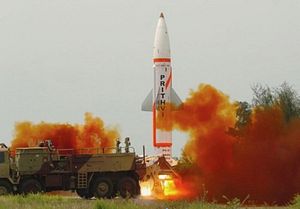For the fourth time this month, India’s Strategic Forces Command (SFC) test launched a nuclear capable ballistic missile as part of its annual training cycle to test the combat readiness of the Indian Army’s missile forces.
The Prithvi-II tactical surface-to-surface short-range ballistic missile was test fired from launch complex 3 of the Integrated Test Range at Chandipur on February 21, according to Indian defense sources speaking to local media.
The missile was fired at 830pm local time as part of a nighttime user trial. “The missile trajectory was tracked by radars, electro-optical tracking systems and telemetry stations by the DRDO (Defense Research and Development Organization) along the coast of Odisha,” sources stated.
The missile’s terminal flight phase and splashdown near the designated target area was monitored by DRDO scientists. All test objectives were reportedly met. The Indian Ministry of Defense (MoD) has so far not publicly confirmed the success of the test.
As during a previous daytime launch of a Prithvi-II on February 7, the missile was randomly selected from production stock and launched from a transporter erector launcher.
“The single-state, liquid fuel missile, developed by DRDO in the 1990s and early 2000s under the so-called Integrated Guided Missile Development Program, was first introduced into service in 2003,” I explained previously. “It has an operational range of around 350 kilometers and can alternatively be armed with a 500-1,000 kilogram conventional or nuclear warhead.”
The February 21 test marks the fourth test of a nuclear-ballistic missile this month. In addition to the February 7 test of a Prithvi-II, the SFC successfully test fired an Agni-I short-range nuclear capable ballistic missile on February 6 and an Agni-II medium to intermediate range ballistic missile on February 20. It remains unclear whether yesterday’s Agni-II test was successful or not. Notably, the missile last failed user trials in May 2017.
“There has been an ongoing concern that the two-stage solid-fueled Agni-II—the purported backbone of India’s land-based nuclear deterrent—was inducted into service prematurely,” I wrote earlier this week. “Other tests, including a nighttime test of the missile in 2009, also ended in failure.” The Agni-II, first deployed in 2004, has a maximum range of 2,000-3,000 kilometers. It is road and rail mobile.
In January 2018, the SFC also successfully tested its most advanced nuclear-capable intercontinental ballistic missile (ICBM), the Agni-V, a three-stage solid fuel missile with an estimated operational range of 5,500-5,800 kilometers. The missile can be fitted with a 1,500 kilogram nuclear payload and is designed to provide a credible nuclear deterrent against China.































